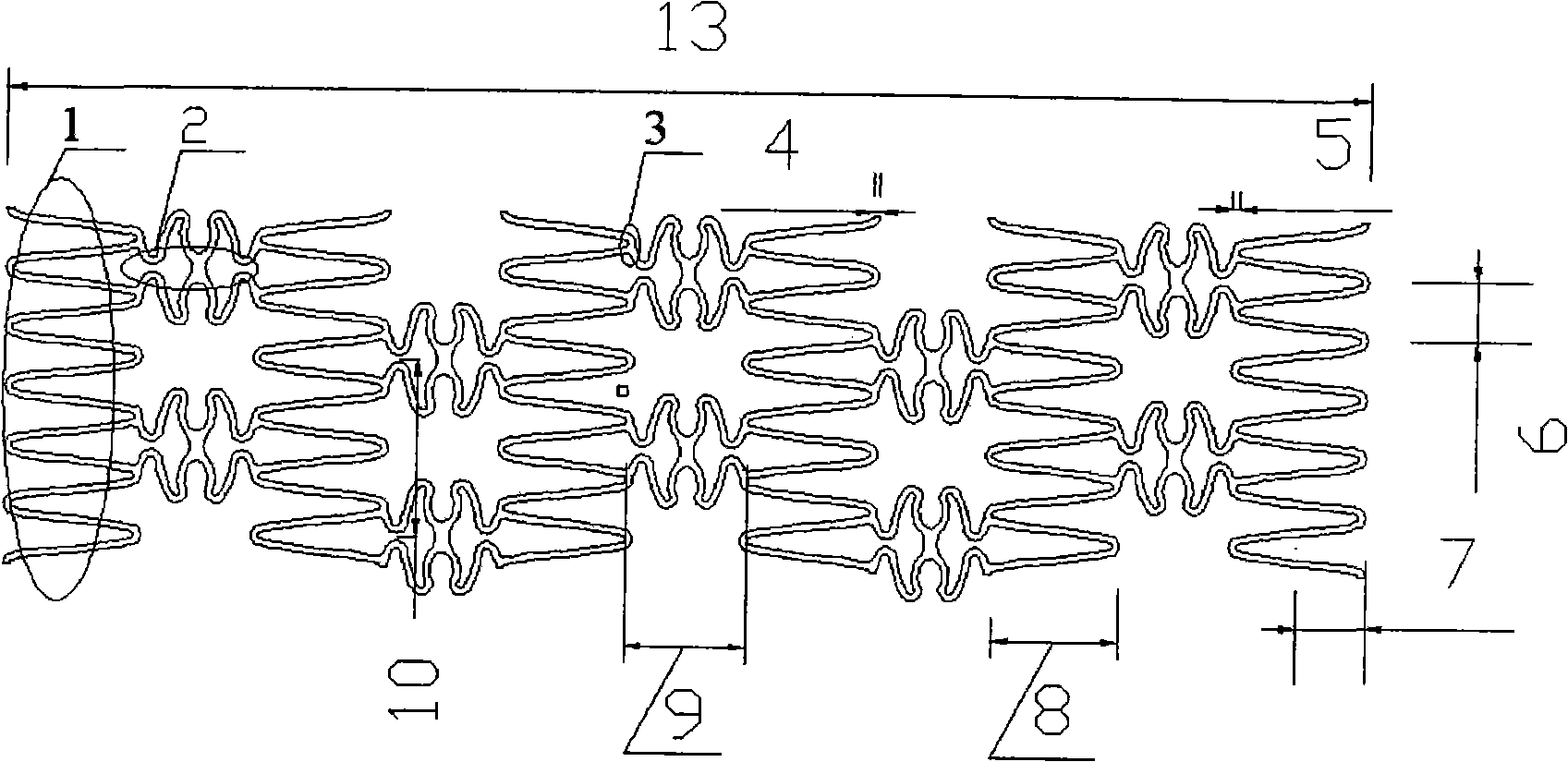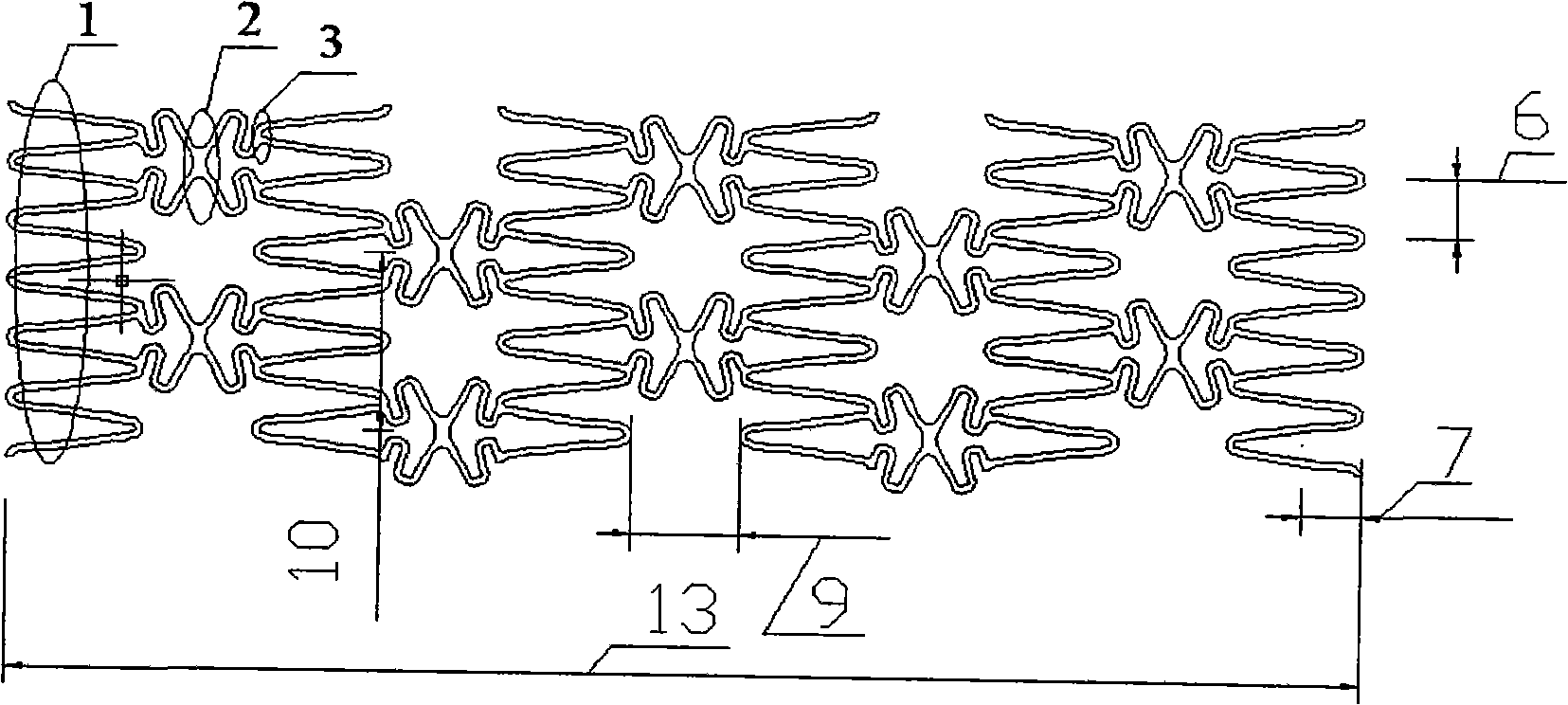Human endoluminal stent with radial large deformation large holding power
A technology with large deformation and supporting force, applied in the direction of human tubular structure devices, stents, blood vessels, etc., can solve the problems of small radial supporting force of stents, tearing and damage over connection points, and poor body fluid flow performance. The effect of large radial deformation, good structural stability, and flat surface of the stent
- Summary
- Abstract
- Description
- Claims
- Application Information
AI Technical Summary
Problems solved by technology
Method used
Image
Examples
Embodiment 1
[0017] see figure 1 , a tubular stent for blood vessels in the human body, which is etched from a superelastic nickel-titanium alloy tube and has a tubular network structure. The stent is composed of a plurality of sinusoidal circular ring-shaped basic structures 1 distributed along its axial direction, Between every two adjacent sinusoidal circular ring-shaped basic structures 1, the crests of the sine waves face each other, and they are connected by a connector 2 with "Ω"-shaped structures on both sides and back-to-back. The connection point 3 is selected on the sinusoidal waveform circle. At the crest position of the ring-shaped basic structure 1. Between every two adjacent sinusoidal circular ring-shaped basic structures 1, the "Ω"-shaped connectors 2 on both sides are distributed at equal intervals. times. The rib width 5 of the connecting part 2 is equal to the rib width 4 of the sinusoidally waved ring-shaped basic structure 1 .
[0018] The outer diameter 11 of the ...
Embodiment 2
[0022] see figure 2 , a tubular stent for blood vessels in the human body is etched from a superelastic nickel-titanium alloy tube and has a tubular network structure. The tubular stent for blood vessels is composed of a plurality of sinusoidal circular ring-shaped basic structures 1 distributed along its axial direction , between each two adjacent sinusoidal circular ring-shaped basic structures 1, the crests of the sine waves face each other, and they are connected by connectors 2 with "Ω"-shaped structures on both sides and back-to-back, and the connection point 3 is selected in the sinusoidal waveform On the crest position of the ring-shaped basic structure 1. Between every two adjacent sinusoidal circular ring-shaped basic structures 1 , the connectors 2 are distributed at equal intervals, and the distance 10 is 2.61 mm, which is three times the sine wave wavelength 6 of the sinusoidal circular ring-shaped basic structures 1 . The rib width 5 of the back-to-back "Ω"-sha...
Embodiment 3
[0024] refer to image 3 , a tubular stent for blood vessels in the human body is etched from a superelastic nickel-titanium alloy tube and has a tubular network structure. The tubular stent for blood vessels is composed of a plurality of sinusoidal circular ring-shaped basic structures 1 distributed along its axial direction , between each two adjacent sinusoidal circular ring-shaped basic structures 1, the crests of the sine waves face each other, and they are connected by connectors 2 with "Ω"-shaped structures on both sides and back-to-back, and the connection point 3 is selected in the sinusoidal waveform On the crest position of the ring-shaped basic structure 1. Between every two adjacent sinusoidal circular ring-shaped basic structures 1, the "Ω"-shaped connectors 2 on both sides are distributed at equal intervals. 3 times of wavelength 6. The rib width 5 of the back-to-back "Ω"-shaped connector 2 on both sides is equal to the rib width 4 of the sinusoidal ring-shape...
PUM
| Property | Measurement | Unit |
|---|---|---|
| length | aaaaa | aaaaa |
| thickness | aaaaa | aaaaa |
| length | aaaaa | aaaaa |
Abstract
Description
Claims
Application Information
 Login to View More
Login to View More - R&D
- Intellectual Property
- Life Sciences
- Materials
- Tech Scout
- Unparalleled Data Quality
- Higher Quality Content
- 60% Fewer Hallucinations
Browse by: Latest US Patents, China's latest patents, Technical Efficacy Thesaurus, Application Domain, Technology Topic, Popular Technical Reports.
© 2025 PatSnap. All rights reserved.Legal|Privacy policy|Modern Slavery Act Transparency Statement|Sitemap|About US| Contact US: help@patsnap.com



